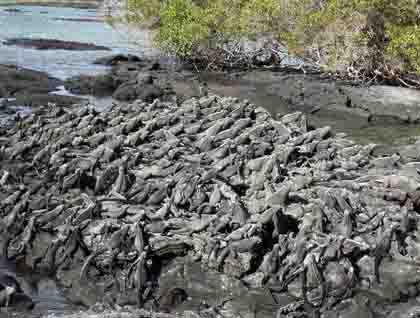We left the central part of Galapagos heading west to visit the youngest islands, Fernandina and Isabela. Baptized in honor of the Queen and King of Spain who helped Columbus to discover America in 1492, these islands are located along the ring of fire with six of the most active volcanoes in the world.
Last night we crossed the Equator twice and after a long navigation, we finally arrived to the Bolivar Channel that separates Isabela and Fernandina Islands. Early in the morning our guests had the opportunity to observe the marine life and the gigantic volcanoes while the first beams of sun appeared from the east. The sea was very calm and many marine birds such as storm petrels, shearwaters and blue footed boobies in feeding frenzy tried to catch some fish.
After breakfast we headed to Fernandina Island. From the Zodiacs we observed flightless cormorants, sea lions and sea turtles swimming indifferently while in the air two Galapagos hawks flew around the rocks. The volcano looked gigantic with its solidified black lava flows, mute evidence of recent eruptions. Walking along the seashore we observed hundreds of marine iguanas warming their blackish bodies as petrified rocks; from time to time we heard them sneezing, secreting the excess of salt from their bodies. Walking along the white beaches we observed Galapagos sea lions and many flightless cormorants nesting on the rocks; we observed some chicks with their fluffy feathers underneath their parents and some males bringing seaweed to their mate to make their nests. Just before finishing the visit our guests observed a Galapagos snake; it was close to us, unperturbed and moving slowly among the rocks. What an experience!!
One of the best attractions was waiting for us during the Zodiac ride back to the ship; we observed three Sunfish swimming together with their triangular dorsal fins outside the water. They probably had a 5 foot diameter and stayed there for many minutes, enough to take many photos from different angles.
In the afternoon we dropped anchor in Punta Vicente Roca at Isabela Island, just beside the Ecuador volcano. It looked impressive with big waves breaking along the rocks and cloudy on the top. We started the activities snorkeling along the shore observing sea lions, sea turtles and flightless cormorants trying to catch some fish. Afterwards we came back to explore the coastline from the Zodiacs observing Galapagos penguins, fur sea lions on the rocks and many green sea turtles showing their heads, as calling us to be observed.
It was late when the National Geographic Endeavour moved north and crossed the Equator line. We all shared great moments with our guests about “crossing the line” and enjoyed a beautiful sunset that told us the day was over, leaving in our minds incredible places and unique creatures in this last paradise called Galapagos.







